Direct mail is back in the mix: consumers consider mail believable as digital channels face ‘trust fatigue’
Marketers that remain fixated with digital channels might need to rethink their strategy. New research has revealed that 87% of consumers consider mail communications to be ‘believable’, while only 48% feel the same way about email. The same research found that mail is regarded as ‘more likely to grab the recipient’s attention’.

The letterbox is back in the mix for marketers.
Conducted in May of this year by Royal Mail MarketReach and TNS, the research followed the same model set by studies carried out in 2007 and 2013, allowing shifts in consumer opinion to be tracked over a ten-year period. The surveys included several questions addressing emotional engagement, ie how mail makes the respondent feel about the sender organisation, and what it implies about how that organisation regards them personally.
Between 2007 and 2017, the percentage of people stating that mail makes them ‘feel valued’ has increased to 70%, compared to only 43% in 2007 and 57% in 2013. 70% also responded that mail also ‘gives them a better impression of the company’, again rising from 53% in 2007 and 55% in 2013.
The findings confirm that, in a digital world, where a vast and growing volume of emails are sent every day, the comparative rarity of real-world ‘physical’ mail has led to it becoming increasingly valued and trusted by consumers. Better yet for marketers, the media can positively impact on the perceived trustworthiness of the communication itself and help to create a more rounded, more believable brand identity.
It's interesting to note that, while marketers often debate how best to mix the strengths of the various mediums available to them, little thought is dedicated to how consumers’ relationships to those mediums may evolve over time. One potential reason for consumers’ positive shift towards mail may be, ironically, the way that marketers have over-utilised email marketing in the past, eg sending too many irrelevant emails to the wrong targets.
Likewise, in the age of fake news, malware and phishing, it may be that a wider, growing unease or ‘trust fatigue’ with digital channels is fuelling the increased consumer desire for the trustworthiness and tangibility of mail.
But it’s not just all about the ‘feels’: the recent IPA TouchPoints survey tracked the range of responses from consumers to receiving mail and found that commercially relevant responses included increased enquiries online and by phone, increased store visits, purchases and service renewals. A Brand Science review of multi-channel campaigns concluded that when mail was included in the marketing mix, campaigns had 12% bigger ROI than those without mail.
While digital communications remain a key and crucial part of the marketer’s toolkit, this latest research makes it clear that email cannot be regarded as a straight replacement for mail, nor is it likely to deliver the same results in terms of consumer engagement and sales performance.
The full MarketReach research report - ‘The Value of Mail in Uncertain Times’ – is now available to download for free, offering insights and advice on how best to utilise mail as a component of multichannel marketing campaign.


